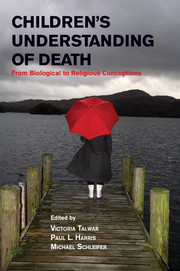Crossref Citations
This Book has been
cited by the following publications. This list is generated based on data provided by Crossref.
Gelman, Susan A.
and
Legare, Cristine H.
2011.
Concepts and Folk Theories.
Annual Review of Anthropology,
Vol. 40,
Issue. 1,
p.
379.
Legare, Cristine H.
Evans, E. Margaret
Rosengren, Karl S.
and
Harris, Paul L.
2012.
The Coexistence of Natural and Supernatural Explanations Across Cultures and Development.
Child Development,
Vol. 83,
Issue. 3,
p.
779.
Lee, Ji Seong
Kim, Eun Young
Choi, Younyoung
and
Koo, Ja Hyouk
2014.
Cultural Variances in Composition of Biological and Supernatural Concepts of Death: A Content Analysis of Children's Literature.
Death Studies,
Vol. 38,
Issue. 8,
p.
538.
2014.
REFERENCES.
Monographs of the Society for Research in Child Development,
Vol. 79,
Issue. 1,
p.
125.
Widger, Tom
2015.
Suicide and the ‘Poison Complex’: Toxic Relationalities, Child Development, and the Sri Lankan Self-Harm Epidemic.
Medical Anthropology,
Vol. 34,
Issue. 6,
p.
501.
Sanders, Dawn
and
Hohenstein, Jill
2015.
“Death on Display:” Reflections on Taxidermy and Children's Understanding of Life and Death.
Curator: The Museum Journal,
Vol. 58,
Issue. 3,
p.
251.
McTiernan, Kara
and
O'Connell, Michael
2015.
An interpretative phenomenological analysis exploring the lived experience of individuals dying from terminal cancer in Ireland.
Palliative and Supportive Care,
Vol. 13,
Issue. 3,
p.
641.
Astuti, Rita
2016.
On combining natural and social histories into one and the same process.
HAU: Journal of Ethnographic Theory,
Vol. 6,
Issue. 1,
p.
449.
Coombs, Sarah
2017.
Young People's Perspectives on End-of-Life.
p.
17.
Stylianou, Polyxeni
and
Zembylas, Michalinos
2018.
Dealing With the Concepts of “Grief” and “Grieving” in the Classroom: Children’s Perceptions, Emotions, and Behavior.
OMEGA - Journal of Death and Dying,
Vol. 77,
Issue. 3,
p.
240.
2018.
REFERENCES.
Monographs of the Society for Research in Child Development,
Vol. 83,
Issue. 3,
p.
100.
Vázquez-Sánchez, Juan Manuel
Fernández-Alcántara, Manuel
García-Caro, Mª Paz
Cabañero-Martínez, Mª José
Martí-García, Celia
and
Montoya-Juárez, Rafael
2019.
The concept of death in children aged from 9 to 11 years: Evidence through inductive and deductive analysis of drawings.
Death Studies,
Vol. 43,
Issue. 8,
p.
467.
Clemente, Ignasi
2020.
Discourses on the Edges of Life.
Vol. 26,
Issue. ,
p.
86.
Sánchez Aguilar, Raúl
Bascaran Virto, Natalia
Díaz Martín, Silvia
Marín Díaz, Marta
and
Rodríguez Cuadrado, Sara
2021.
Intervención escolar sobre la muerte a partir del currículo español en educación infantil y primaria.
SUMMA. Revista disciplinaria en ciencias económicas y sociales,
Vol. 3,
Issue. 2,
p.
1.
Zajac, Lindsay
and
Boyatzis, Chris James
2023.
A Death in the Family: Links between Religion, Parenting, and Family Communication about Death.
Religions,
Vol. 14,
Issue. 2,
p.
254.
Vukomanović-Rastegorac, Vladimir
2023.
Who needs a methodological course about death in the poetry for children and Youth?: Students' motivation for this course, their concepts and experience related to death.
Inovacije u nastavi,
Vol. 36,
Issue. 3,
p.
97.
Danielson, Katie
and
Colman, Hailey
2023.
Supporting Children Through Grief: A Content Analysis of Picturebooks About Death.
Early Childhood Education Journal,





